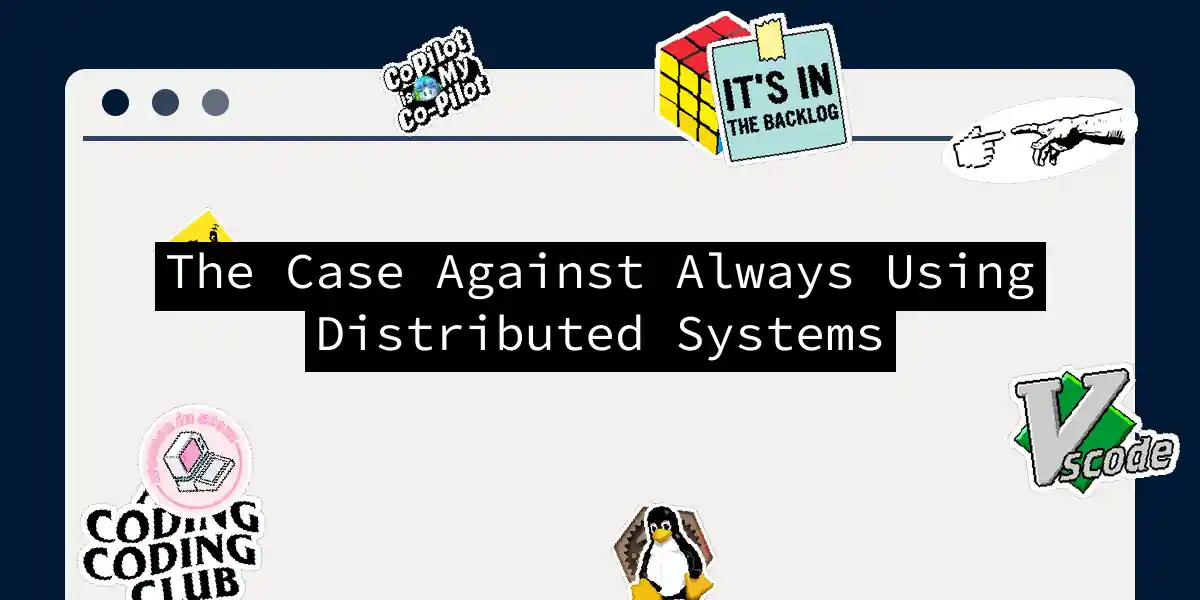When it comes to building modern software systems, the allure of distributed systems can be overwhelming. They promise scalability, high availability, and the ability to handle massive loads, making them a go-to choice for many developers. However, beneath the glossy surface of distributed systems lies a complex web of challenges that can turn your dream project into a nightmare.
The Fallacies of Distributed Systems
Before we dive into the nitty-gritty, let’s address some common fallacies that often lead developers down the path of distributed systems without fully understanding the implications.
The Network is Reliable: One of the deadliest mistakes is assuming the network will always work without any problems. Networks are inherently vulnerable to failures such as packet drops, delays, and connection losses. These issues can arise from hardware breakdowns, software glitches, or physical disruptions[5].
Latency is Zero: Another misconception is that data transfer is instantaneous. Latency, caused by factors like distance, network congestion, and processing delays, can significantly impact your system’s performance. Techniques like caching and asynchronous communications can help mitigate this, but they add complexity[5].
Bandwidth is Infinite: Unlimited bandwidth is a myth. In high-tempo applications, bandwidth can be a rate-limiting factor. Effective bandwidth management through compression, data encoding, and prioritization is crucial for maintaining performance[5].
The Network is Secure: Believing the network is inherently secure is a recipe for disaster. Networks can be tapped, breached, and attacked by malicious actors. Ensuring security involves robust measures like encryption, firewalls, and continuous monitoring[5].
The Complexity of Distributed Systems
Distributed systems introduce a level of complexity that can be daunting even for experienced developers.
Partial Failures and Unknown States
In a distributed system, partial failures can lead to unknown states. For example, if a stock service crashes while processing an order, it’s unclear whether the order was created or the stock was updated. This uncertainty necessitates complex retry mechanisms and error handling, which can be tricky to implement correctly[3].
Time and Synchronization
Each component in a distributed system has its own view of time, and even with solutions like NTP, time drift is inevitable. This makes it impossible to rely on wall clocks to order events, adding another layer of complexity to your system[3].
Data Consistency
In distributed systems, data is often stored across multiple storage systems, each with its own persistence mechanisms. This can lead to inconsistent data if not managed properly. For instance, two requests to get an order could yield contradictory results if the stock storage system uses eventual consistency[3].
The Operational Nightmare
Developing a distributed system is just the beginning; maintaining it is where the real challenges lie.
Tribal Knowledge
When you build a custom distributed system, the knowledge about it is often tribal, meaning it is passed down directly from the developers to the operations team. This lack of external resources and documentation can make troubleshooting and maintenance incredibly difficult. There’s no Google search or Stack Overflow answer to save the day; you are the bottleneck[2].
Continuous Problem-Solving
With a custom distributed system, you’ll spend more time fixing problems than creating new features. Every issue escalates to you, and the operations team has limited resources to troubleshoot on their own. This can turn your role from a developer into a full-time firefighter, constantly plugging holes in your system[2].
The Cost of Custom Solutions
One of the most compelling reasons to avoid building your own distributed system is the sheer cost involved.
Time and Resources
Building a distributed system from scratch is a time-consuming and resource-intensive task. It requires extensive testing, including testing for all possible failure modes, which can balloon your test matrix exponentially. For example, what might be 10 scenarios to test in a single-machine version could become 200 scenarios in a distributed system[4].
Opportunity Cost
The time and resources spent on building and maintaining a custom distributed system could be better spent on other aspects of your project. Using existing distributed systems allows you to leverage the collective knowledge and effort of the community, freeing you to focus on your core business logic and features[2].
When to Use Distributed Systems
Despite the challenges, there are scenarios where distributed systems are the right choice.
Scalability and High Availability
If your application requires scalability and high availability, distributed systems can provide the necessary infrastructure. For example, cloud services like Amazon Web Services (AWS) are built on distributed systems to handle massive loads and ensure continuous operation[4].
Complex Use Cases
Certain use cases, such as real-time data processing or distributed databases, inherently require distributed systems. Here, the benefits of distributed systems outweigh the costs, and the complexity is justified by the functionality[3].
Conclusion
Distributed systems are not a one-size-fits-all solution. While they offer scalability and high availability, they come with a host of complexities and challenges that can make them more trouble than they’re worth for many projects.
Before embarking on the journey of building a distributed system, take a step back and ask yourself:
- Do I really need the scalability and high availability that distributed systems offer?
- Have I considered the operational and maintenance costs?
- Are there existing solutions that could meet my needs without the added complexity?
Here is a simple flowchart to help you decide:
In the end, the decision to use a distributed system should be based on a thorough analysis of your project’s requirements and the potential costs involved. Sometimes, the simplest solution is the best one, and avoiding the complexities of distributed systems can save you a world of trouble.
